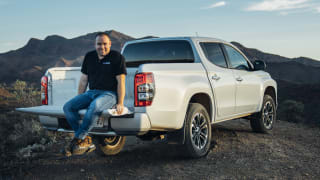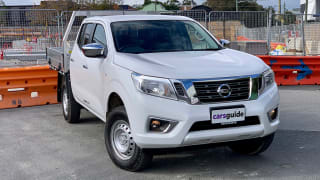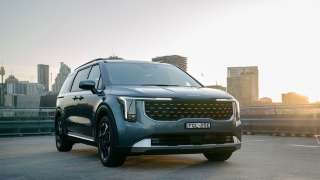This Ranger’s tray is standard dual-cab tray size at 1549mm long (at the floor) and 1560mm wide, but it is 1139mm wide (between the wheel-arches) – and that’s not wide enough to cop an Aussie pallet, which is 1165mm wide.
From ground to floor load-height is 835mm and the rear opening is 1330mm wide.
There are four tie-down points in the tray – one at each corner – but no power sockets.
2020 Ranger Wildtrak featured below:
Explore the Ranger Wildtrak in the Ford Tradie Workshop
Discover new features of the Ranger Wildtrak designed for a Tradie
The lift-assist tailgate has a slow-ish drop to it when opened and is easy and smooth to lift and shift again. It has a manual lock.
To protect this ute’s rear window from potential damage when you’re carrying heavier, harder-edged loads, the tray is equipped with a cab guard, basically vertical metal struts that sit proud of the glass and are designed to somewhat shield that surface from the load in your tray if it shifts forward.
I wanted to load up the Ranger so I headed to our mates at Agriwest Rural CRT Bomaderry and we threw 780kg of horse feed in the tray. With that load onboard, the front of the Ranger lifted 30.5mm, and its rear-end dropped 77mm.
Add to that a, ahem, 90kg driver and assorted in-cabin gear and we were tickling 100kg in terms of cabin weight, so, with the load in the tray, that’s a total of 880kg onboard the XL.
This Ranger’s payload is listed as a decent 1230kg. (Payload is gross vehicle mass – GVM, in this case 3200kg – minus the vehicle’s kerb weight, which, in this case, is 1970kg.) Remember: any payload figure has to take into account the combined weight of driver, passengers, pets, and all your gear, and, it’s worthwhile noting too, that if you decide to add any aftermarket gear to your ute – bullbar, canopy etc – that will also ‘eat into’ your vehicle’s payload capacity.
So, was the Ranger’s ride and handling at all adversely affected as a result of almost 900kg extra kilos in it? No, the bulky burden never registered in a negative way, but it did smooth out the ride even more and make it even more compliant than it was unladen.
The suspension remains settled, even through more pronounced speed bumps. As mentioned, our test vehicle did not have the optional $500 heavy-duty suspension pack, but it did fine and was very comfortable without the thicker rear springs, revised spring rates and specific ABS and ESC calibration.
The Ranger performs consistently well in most aspects under load: steering continues with that nice light feel; the transmission held consistent speed going uphill – not kicking down or revving too harshly; and the 2.2-litre engine was never over-worked and always seemed to have grunt enough and be responsiveness enough to move the whole loaded-up Ranger along smoothly, with little to no stress.
Any niggles that revealed themselves during the laden section of this drive had been evident during unladen drive loops – including that aforementioned low-speed drivetrain vibration, and marginal lag once your boot’s down etc – so the load couldn’t cop the blame for those lingering characteristics.
This Ranger was controlled and comfortable at all times – and, for the driver, knowing that, and getting that distinct impression consistently from your load-carrying vehicle inspires a lot of confidence.




















